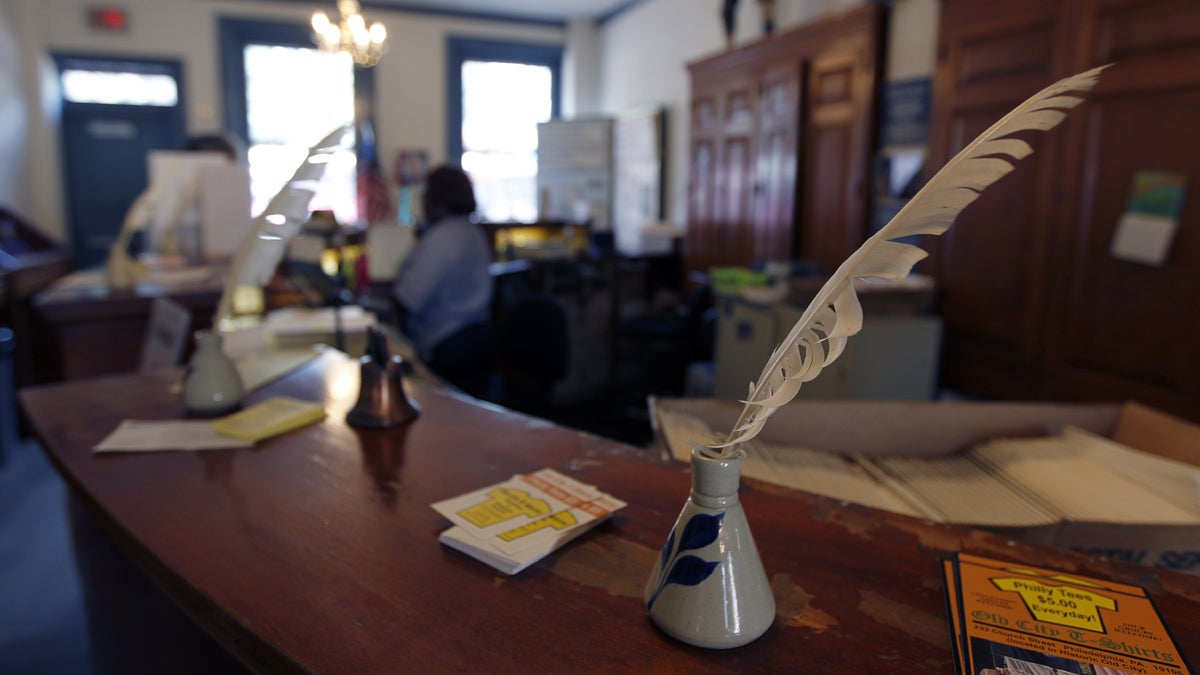Whatever happened to penmanship?
Have we lost the art of good handwriting, an art that indicates patience, care and self-respect?

A feather quill pen is inside the United States Post Office that predates the American colonies in the Old City neighborhood of Philadelphia. (AP Photo/Alex Brandon, file)
Jane Austen, whose 200th anniversary we celebrate this year, was not only a prolific author of novels; but also a strong devotee of good penmanship. She apparently wrote 14 novels and some 3,000 letters in a lifespan of 42 years.
Have we lost the art of good handwriting, an art that indicates patience, care and self-respect? Some countries, like Finland, have already given up, having since 2015 taught keyboard lessons in lieu of handwriting.
Being in need of such lessons myself and being ensconced among the ranks of the technologically challenged, I suggested some years ago the formation of a society for the return of the quill pen. Taking me at my word, my wife gave me a present of a beautiful scarlet quill in a silver holder and accompanied by a miniature bottle of ink. I used it once — to pen a note of thanks.
What is cursive handwriting? The word comes from the Latin currere, meaning “to run,” which is what the letters do — flowing and joined up, running across the page.
However, sometimes cursive writing can more literally turn out to be a curse. Take, for instance, its sometimes negative effects in medicine. In its report, “To Err is Human,” the Institute of Medicine estimated that medical errors cause at least an estimated annual 7,000 preventable deaths attributable to doctors’ illegible handwriting and The Institute for Safe Medication Practices, located in suburban Philadelphia, often receives medication error reports that result in confusion with drug names that look or sound alike. Hardly surprising when you consider that more than four billion prescriptions are written for Americans every year.
But there are other pitfalls for bad writing. One of these is dysgraphia, a deficiency in the ability to write, from the Greek meaning “impaired writing by hand.” In the Diagnostic and Statistical Manual of Mental Disorders, dysgraphia is characterized as a learning disability in the category of written expression when one’s writing skills are below those expected for a person’s age.
The emergence of email, 140-character tweets, emojis, and a general disregard for elegant prose altogether have all conspired to erode handwriting. Will this lead to a return to grunts and hieroglyphics or the use of an X in place of a florid signature on documents.
Julia Wood, an occupational therapist at Penn Medicine, who helps people with dysgraphia, says that lapses into illegibility are reversible. It’s just a matter of practice and encouragement and a focus on “difficult” letters, especially p, q, b, and r. She notes that there’s a domino effect, too, with poor math scores correlating with poor writing, and she points to a study conducted at Florida International University showing that 4-year-olds with superior writing skills do far better in elementary school than their peers.
And a poll of 1,000 teens by the stationers Bic found that one in 10 don’t own a pen, a third have never written a letter, and half of 13- to 19-year-olds have never been forced to sit down and write a thank-you letter — 56 percent don’t even have letter paper at home, and a quarter have never known the joys of writing a birthday card, even though most of the sentiments appearing in such cards are already pre-written.
In an article titled “The Secrets of Jane Austen’s Handwriting,” graphologist Patricia Field quotes from the novel “Pride and Prejudice”:
“Charles writes in the most careless way imaginable. He leaves out half his words and blots the rest.”
And, to be sure, few if any authors today could match Jane Austen’s prolific output of words using only a pen — and a quill pen at that.
WHYY is your source for fact-based, in-depth journalism and information. As a nonprofit organization, we rely on financial support from readers like you. Please give today.





